North Texas cities prepare for total solar eclipse in 2 months

Total solar eclipse to happen over DFW in 2 months
We are exactly two months away from a rare and extraordinary event. North Texas will be one of the best places in the world to see a total solar eclipse. FOX 4's Shannon Murray has an update on some of the plans.
DALLAS - Local cities are preparing for large crowds for the total solar eclipse in two months. Dallas-Fort Worth will be directly in the path of totality.
Visitors from around the world are expected to gather in North Texas on April 8 to watch as the moon lines up perfectly between the Earth and the sun.

File: The sun is is in full eclipse over Grand Teton National Park on August 21, 2017 outside Jackson, Wyoming. (Photo by George Frey/Getty Images)
MORE: Solar Eclipse News
The path of totality is 115 miles wide and stretches from Mexico to Newfoundland.
DFW is one of the largest metro areas with a vantage point.
Many hotels, campgrounds, and viewing events are already sold out.
School districts are working behind the scenes to prepare their students.
Some are making it part of the school day and ordering protective eyewear for students and staff.
Others are canceling classes.
Ennis ISD recently announced it would close for the total eclipse to allow students to experience it with their families.
Their city is directly on the center line and has a longer duration of totality than most other surrounding cities.
Ennis city leaders are expecting up to 200,000 visitors in town for the event.
Sulphur Springs is also near the center line. The school district there also decided to close.
The eclipse will last up to four minutes and 28 seconds in the path of total darkness. That’s twice as long as the total solar eclipse in 2017.
The next total solar eclipse visible in North Texas will be in 294 years.



